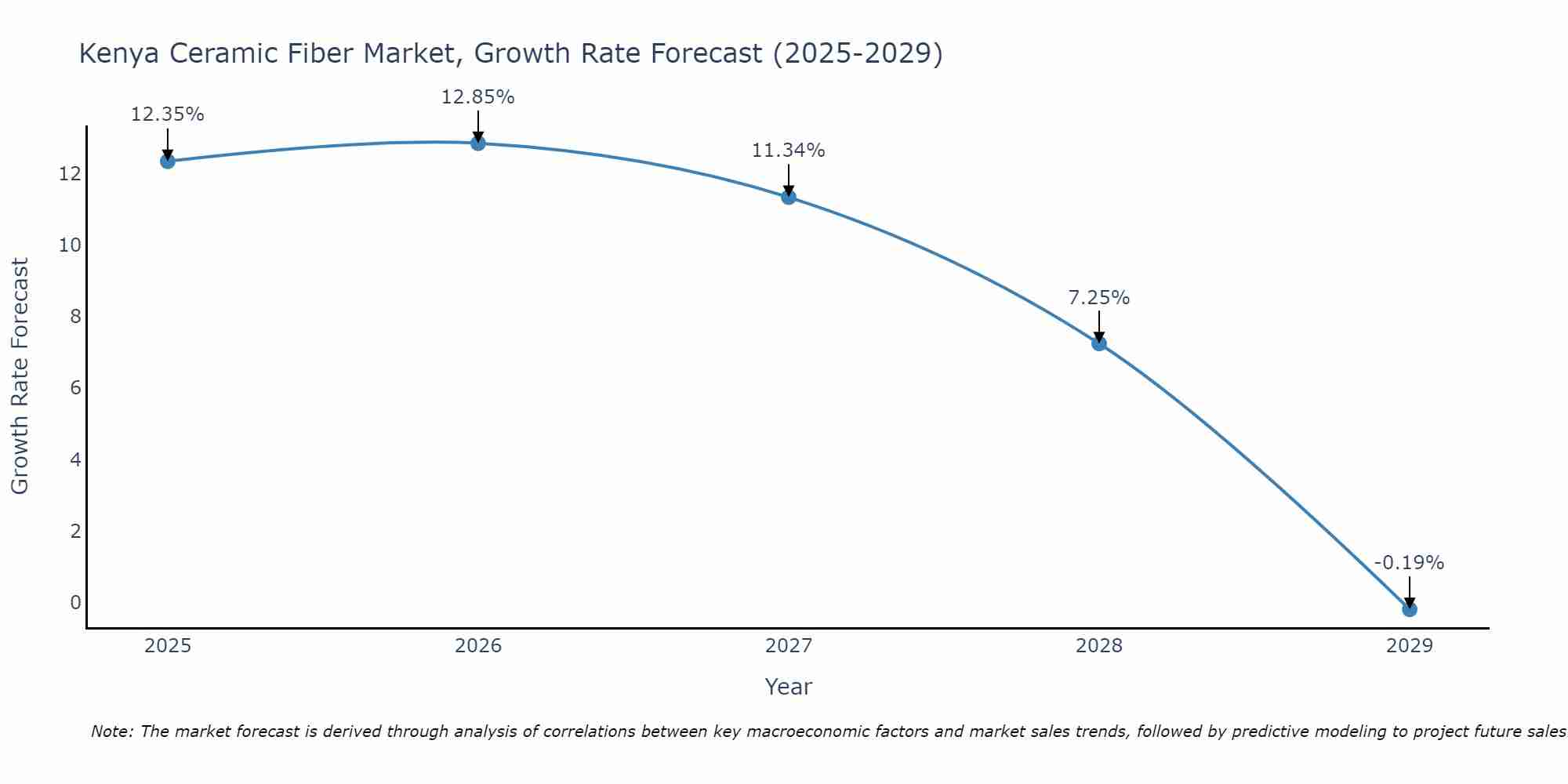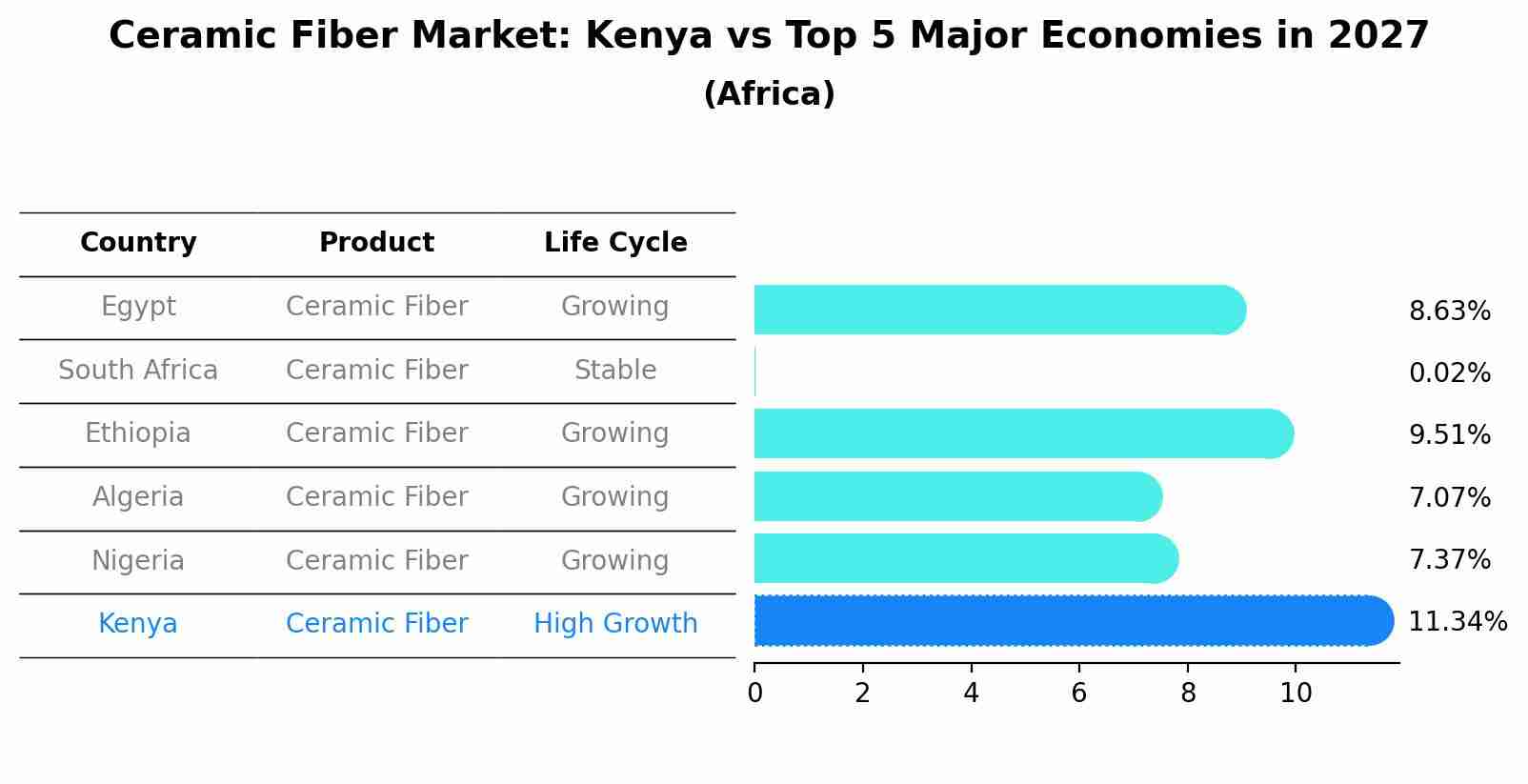Kenya Ceramic Fiber Market Outlook | Size, Growth, Forecast, COVID-19 IMPACT, Trends, Revenue, Industry, Companies, Share, Value & Analysis
| Product Code: ETC374030 | Publication Date: Aug 2022 | Updated Date: Apr 2025 | Product Type: Market Research Report | |
| Publisher: 6Wresearch | Author: Ravi Bhandari | No. of Pages: 75 | No. of Figures: 35 | No. of Tables: 20 |
Kenya Ceramic Fiber Market Size Growth Rate
The Kenya Ceramic Fiber Market is projected to witness mixed growth rate patterns during 2025 to 2029. The growth rate begins at 12.35% in 2025, climbs to a high of 12.85% in 2026, and moderates to -0.19% by 2029.

Ceramic Fiber Market: Kenya vs Top 5 Major Economies in 2027 (Africa)
The Ceramic Fiber market in Kenya is projected to grow at a high growth rate of 11.34% by 2027, highlighting the country's increasing focus on advanced technologies within the Africa region, where Egypt holds the dominant position, followed closely by South Africa, Ethiopia, Algeria and Nigeria, shaping overall regional demand.

Kenya Ceramic Fiber Market Overview
The Kenya Ceramic Fiber Market is growing, driven by the demand for high-temperature insulation materials in industrial applications. Ceramic fibers offer excellent thermal stability and energy efficiency, making them essential in industries such as petrochemicals, power generation, and metallurgy. The market benefits from the focus on energy conservation and industrial efficiency.
Drivers of the market
In Kenya, the ceramic fiber market experiences growth driven by several factors including the increasing demand for high-temperature insulation materials, expanding industrial sectors such as steel, petrochemicals, and power generation, and advancements in material science and manufacturing processes. Ceramic fibers, known for their excellent thermal insulation properties, chemical resistance, and lightweight nature, find applications in furnace linings, kiln insulation, heat shields, and fireproofing solutions. With the growing emphasis on energy efficiency, safety regulations, and process optimization in industrial operations in Kenya, there is a rising demand for ceramic fiber products to improve thermal management, reduce heat loss, and enhance workplace safety. Moreover, the adoption of ceramic fiber composites and innovative insulation systems further fuel market growth by offering lightweight, durable, and cost-effective solutions for high-temperature applications in Kenya.
Challenges of the market
Challenges facing the Kenya ceramic fiber market include the high cost of raw materials and energy-intensive manufacturing processes. Moreover, competition from alternative insulation materials and concerns regarding health and safety risks associated with ceramic fiber usage impact market demand and adoption.
Government Policy of the market
In the ceramic fiber market, the Kenya government focuses on supporting high-temperature insulation applications in industries such as power generation and metallurgy. Policies include providing subsidies for the local production of ceramic fibers, funding research into advanced fiber technologies, and ensuring strict regulatory standards to guarantee product safety and performance. The government also promotes the adoption of energy-efficient insulation materials to reduce industrial energy consumption.
Key Highlights of the Report:
- Kenya Ceramic Fiber Market Outlook
- Market Size of Kenya Ceramic Fiber Market, 2021
- Forecast of Kenya Ceramic Fiber Market, 2028
- Historical Data and Forecast of Kenya Ceramic Fiber Revenues & Volume for the Period 2018 - 2028
- Kenya Ceramic Fiber Market Trend Evolution
- Kenya Ceramic Fiber Market Drivers and Challenges
- Kenya Ceramic Fiber Price Trends
- Kenya Ceramic Fiber Porter's Five Forces
- Kenya Ceramic Fiber Industry Life Cycle
- Historical Data and Forecast of Kenya Ceramic Fiber Market Revenues & Volume By Type for the Period 2018 - 2028
- Historical Data and Forecast of Kenya Ceramic Fiber Market Revenues & Volume By Refractory Ceramic Fiber for the Period 2018 - 2028
- Historical Data and Forecast of Kenya Ceramic Fiber Market Revenues & Volume By Alkaline Earth Silicate Wool for the Period 2018 - 2028
- Historical Data and Forecast of Kenya Ceramic Fiber Market Revenues & Volume By Product Form for the Period 2018 - 2028
- Historical Data and Forecast of Kenya Ceramic Fiber Market Revenues & Volume By Blanket for the Period 2018 - 2028
- Historical Data and Forecast of Kenya Ceramic Fiber Market Revenues & Volume By Module for the Period 2018 - 2028
- Historical Data and Forecast of Kenya Ceramic Fiber Market Revenues & Volume By Board for the Period 2018 - 2028
- Historical Data and Forecast of Kenya Ceramic Fiber Market Revenues & Volume By Paper for the Period 2018 - 2028
- Historical Data and Forecast of Kenya Ceramic Fiber Market Revenues & Volume By End User for the Period 2018 - 2028
- Historical Data and Forecast of Kenya Ceramic Fiber Market Revenues & Volume By Energy & Power for the Period 2018 - 2028
- Historical Data and Forecast of Kenya Ceramic Fiber Market Revenues & Volume By Iron & Steel for the Period 2018 - 2028
- Historical Data and Forecast of Kenya Ceramic Fiber Market Revenues & Volume By Refining & Petrochemical for the Period 2018 - 2028
- Historical Data and Forecast of Kenya Ceramic Fiber Market Revenues & Volume By Textile for the Period 2018 - 2028
- Historical Data and Forecast of Kenya Ceramic Fiber Market Revenues & Volume By Paper & Pulp for the Period 2018 - 2028
- Kenya Ceramic Fiber Import Export Trade Statistics
- Market Opportunity Assessment By Type
- Market Opportunity Assessment By Product Form
- Market Opportunity Assessment By End User
- Kenya Ceramic Fiber Top Companies Market Share
- Kenya Ceramic Fiber Competitive Benchmarking By Technical and Operational Parameters
- Kenya Ceramic Fiber Company Profiles
- Kenya Ceramic Fiber Key Strategic Recommendations
Frequently Asked Questions About the Market Study (FAQs):
- Single User License$ 1,995
- Department License$ 2,400
- Site License$ 3,120
- Global License$ 3,795
Search
Thought Leadership and Analyst Meet
Our Clients
Related Reports
- Canada Oil and Gas Market (2026-2032) | Share, Segmentation, Value, Industry, Trends, Forecast, Analysis, Size & Revenue, Growth, Competitive Landscape, Outlook, Companies
- Germany Breakfast Food Market (2026-2032) | Industry, Share, Growth, Size, Companies, Value, Analysis, Revenue, Trends, Forecast & Outlook
- Australia Briquette Market (2025-2031) | Growth, Size, Revenue, Forecast, Analysis, Trends, Value, Share, Industry & Companies
- Vietnam System Integrator Market (2025-2031) | Size, Companies, Analysis, Industry, Value, Forecast, Growth, Trends, Revenue & Share
- ASEAN and Thailand Brain Health Supplements Market (2025-2031) | Strategy, Consumer Insights, Analysis, Investment Trends, Opportunities, Growth, Size, Share, Industry, Revenue, Segments, Value, Segmentation, Supply, Forecast, Restraints, Outlook, Competition, Drivers, Trends, Demand, Pricing Analysis, Competitive, Strategic Insights, Companies, Challenges
- ASEAN Bearings Market (2025-2031) | Strategy, Consumer Insights, Analysis, Investment Trends, Opportunities, Growth, Size, Share, Industry, Revenue, Segments, Value, Segmentation, Supply, Forecast, Restraints, Outlook, Competition, Drivers, Trends, Demand, Pricing Analysis, Competitive, Strategic Insights, Companies, Challenges
- Europe Flooring Market (2025-2031) | Outlook, Share, Industry, Trends, Forecast, Companies, Revenue, Size, Analysis, Growth & Value
- Saudi Arabia Manlift Market (2025-2031) | Outlook, Size, Growth, Trends, Companies, Industry, Revenue, Value, Share, Forecast & Analysis
- Uganda Excavator, Crane, and Wheel Loaders Market (2025-2031) | Strategy, Consumer Insights, Analysis, Investment Trends, Opportunities, Growth, Size, Share, Industry, Revenue, Segments, Value, Segmentation, Supply, Forecast, Restraints, Outlook, Competition, Drivers, Trends, Demand, Pricing Analysis, Competitive, Strategic Insights, Companies, Challenges
- Rwanda Excavator, Crane, and Wheel Loaders Market (2025-2031) | Strategy, Consumer Insights, Analysis, Investment Trends, Opportunities, Growth, Size, Share, Industry, Revenue, Segments, Value, Segmentation, Supply, Forecast, Restraints, Outlook, Competition, Drivers, Trends, Demand, Pricing Analysis, Competitive, Strategic Insights, Companies, Challenges
Industry Events and Analyst Meet
Whitepaper
- Middle East & Africa Commercial Security Market Click here to view more.
- Middle East & Africa Fire Safety Systems & Equipment Market Click here to view more.
- GCC Drone Market Click here to view more.
- Middle East Lighting Fixture Market Click here to view more.
- GCC Physical & Perimeter Security Market Click here to view more.
6WResearch In News
- Doha a strategic location for EV manufacturing hub: IPA Qatar
- Demand for luxury TVs surging in the GCC, says Samsung
- Empowering Growth: The Thriving Journey of Bangladesh’s Cable Industry
- Demand for luxury TVs surging in the GCC, says Samsung
- Video call with a traditional healer? Once unthinkable, it’s now common in South Africa
- Intelligent Buildings To Smooth GCC’s Path To Net Zero


















